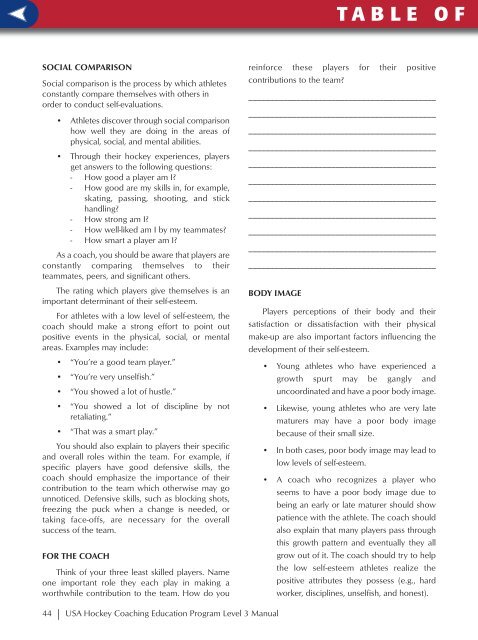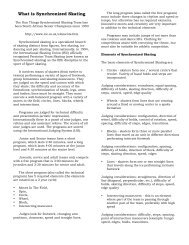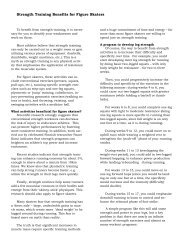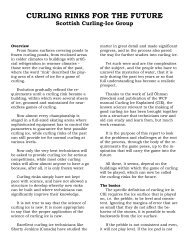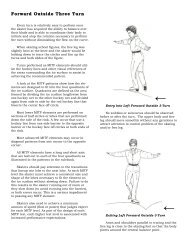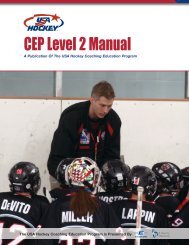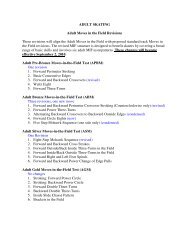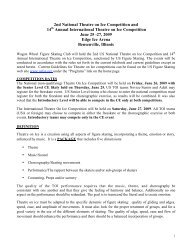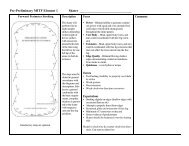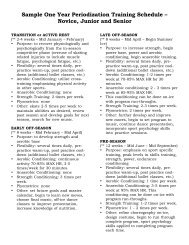CEP Level 3 Manual - Rushmore Hockey Association
CEP Level 3 Manual - Rushmore Hockey Association
CEP Level 3 Manual - Rushmore Hockey Association
Create successful ePaper yourself
Turn your PDF publications into a flip-book with our unique Google optimized e-Paper software.
T A B L E O F C O N T E N T SSOCIAL COMPARISONSocial comparison is the process by which athletesconstantly compare themselves with others inorder to conduct self-evaluations.• Athletes discover through social comparisonhow well they are doing in the areas ofphysical, social, and mental abilities.• Through their hockey experiences, playersget answers to the following questions:- How good a player am I?- How good are my skills in, for example,skating, passing, shooting, and stickhandling?- How strong am I?- How well-liked am I by my teammates?- How smart a player am I?As a coach, you should be aware that players areconstantly comparing themselves to theirteammates, peers, and significant others.The rating which players give themselves is animportant determinant of their self-esteem.For athletes with a low level of self-esteem, thecoach should make a strong effort to point outpositive events in the physical, social, or mentalareas. Examples may include:• “You’re a good team player.”• “You’re very unselfish.”• “You showed a lot of hustle.”• “You showed a lot of discipline by notretaliating.”• “That was a smart play.”You should also explain to players their specificand overall roles within the team. For example, ifspecific players have good defensive skills, thecoach should emphasize the importance of theircontribution to the team which otherwise may gounnoticed. Defensive skills, such as blocking shots,freezing the puck when a change is needed, ortaking face-offs, are necessary for the overallsuccess of the team.FOR THE COACHThink of your three least skilled players. Nameone important role they each play in making aworthwhile contribution to the team. How do youreinforce these players for their positivecontributions to the team?_________________________________________________________________________________________________________________________________________________________________________________________________________________________________________________________________________________________________________________________________________________________________________________________________________________________________________________________________________________________BODY IMAGEPlayers perceptions of their body and theirsatisfaction or dissatisfaction with their physicalmake-up are also important factors influencing thedevelopment of their self-esteem.• Young athletes who have experienced agrowth spurt may be gangly anduncoordinated and have a poor body image.• Likewise, young athletes who are very latematurers may have a poor body imagebecause of their small size.• In both cases, poor body image may lead tolow levels of self-esteem.• A coach who recognizes a player whoseems to have a poor body image due tobeing an early or late maturer should showpatience with the athlete. The coach shouldalso explain that many players pass throughthis growth pattern and eventually they allgrow out of it. The coach should try to helpthe low self-esteem athletes realize thepositive attributes they possess (e.g., hardworker, disciplines, unselfish, and honest).Chapter 6Motivating Your PlayersHOW TO HELP MOTIVATEYOUR PLAYERSOBJECTIVES• Understand motivational techniques• Understand the meaning of success• Learn how to deal with stressAthletes are most highly motivated when theyobtain what they seek from their participation insport. Therefore, motivational techniques shouldbe selected that are based upon the reasonsathletes have for joining the team (provided thattheir motives are healthy for the individual and theteam). The following strategies may help youimprove your players’ motivation.Know your AthletesWhy are they participating?Young athletes differ in their personalities,needs, and objectives for playing hockey. You must,therefore, get to know your athletes as individualsin order to determine why they participate. Oneway to accomplish this is through a team meeting atthe start of the season. Ask your players why theyare participating and what their personal objectivesare for the season. Continue this dialogue before,during and after practices, special events orwhenever you have a chance to talk one-on-onewith your players.Help Athletes Improve Their Skills and Learn NewSkillsSkill improvement is one reason for joining ahockey team. Therefore, practice sessions shouldfocus on skill development, with regularopportunities for players to measure theirprogress. In addition, you can help athletes setperformance goals that are appropriate for them.For example, when young players are first learningto pass, tell them that if they can pass the puck sothat a teammate can receive it without movinghis/her stick, they have been successful. Moreadvanced players should be encouraged to passwithout altering their speed or direction so that theirteammate can receive the puck and continue adeveloping play without hesitations. As playersimprove, they can increase the number of timesthey pass successfully. In this way, your players canmeasure their improvement in performance moreobjectively than by considering only the gameoutcome.44 | USA <strong>Hockey</strong> Coaching Education Program <strong>Level</strong> 3 <strong>Manual</strong>Sport Psychology | 45


